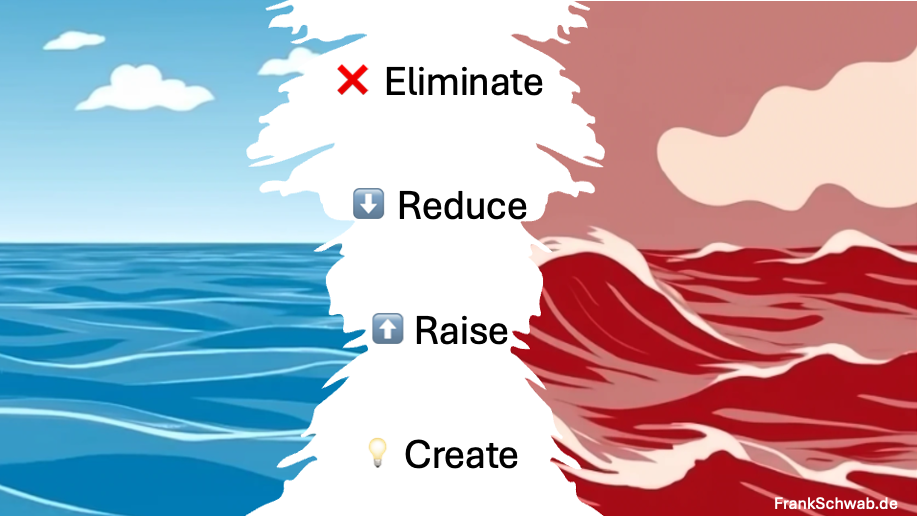Blue Ocean Strategy

The Blue Ocean Strategy (Renée Mauborgne and W. Chan Kim) is a strategic framework that encourages businesses to create uncontested market space ("blue oceans"), rather than competing head-to-head with rivals in existing markets ("red oceans"). It's about finding new opportunities for growth and innovation by offering unique value propositions that attract new customers and make the competition irrelevant.
There are 6 Core Principles of the Blue Ocean Strategy
1️⃣ Reconstruct Market Boundaries: Challenge existing market boundaries and identify opportunities beyond the industry's conventional parameters. This involves looking across alternative industries, strategic groups, buyer groups, complementary product and service offerings, and even across time.
2️⃣ Focus on the Big Picture, Not the Numbers: Instead of getting bogged down by data and figures, the strategy encourages visualizing a big picture of the market to find opportunities for value innovation.
3️⃣ Reach Beyond Existing Demand: The goal is not just to capture existing customers from competitors but to tap into non-customers. There are three tiers of non-customers.
📌 First Tier: "Soon-to-be" non-customers who are on the edge of your market.
📌 Second Tier: "Refusing" non-customers who consciously choose against your market.
📌 Third Tier: "Unexplored" non-customers who are in markets distant from yours.
4️⃣ Get the Strategic Sequence Right: Ensure that your strategy makes sense from the perspective of utility, price, cost, and adoption:
📌 Utility: Does the offering create exceptional utility for the buyer?
📌 Price: Is the price easily accessible to the mass of target buyers?
📌 Cost: Can you achieve your cost target to make the offer profitable?
📌 Adoption: Are there any hurdles in securing adoption?
5️⃣ Overcome Key Organizational Hurdles: Once the strategy is set, there may be internal and external obstacles. Overcoming these involves securing buy-in from the organization by communicating effectively, finding resources, and managing change.
6️⃣ Build Execution into Strategy: Strategy execution should be seamless and include the input of key stakeholders from the beginning, ensuring that the strategy is not just a top-down mandate but is actively supported by the entire organization.
A Core Concept within the Blue Ocean Strategy is the Four Actions Framework. The framework is designed to help businesses break free from traditional competitive thinking and create new market spaces by challenging the conventional assumptions of their industry
The Four Actions Framework
❌ Eliminate: Which factors that the industry takes for granted should be eliminated?
⬇️ Reduce: Which factors should be reduced well below the industry standard?
⬆️ Raise: Which factors should be raised well above the industry standard?
💡 Create: Which factors should be created that the industry has never offered?
In conclusion, the Blue Ocean Strategy encourages businesses to shift their focus from competing within existing markets to creating uncontested market spaces. By redefining industry boundaries, prioritizing value innovation, and tapping into non-customer segments, businesses can break free from the traditional competitive mindset and unlock new opportunities for growth and success. The Four Actions Framework serves as a practical tool to guide this process, challenging companies to question industry norms and create unique value propositions that make the competition irrelevant.
Published in strategy, blue_ocean_strategy, transformation, all on 19.09.2024 9:30 Uhr.

E-Mail address
Comment *